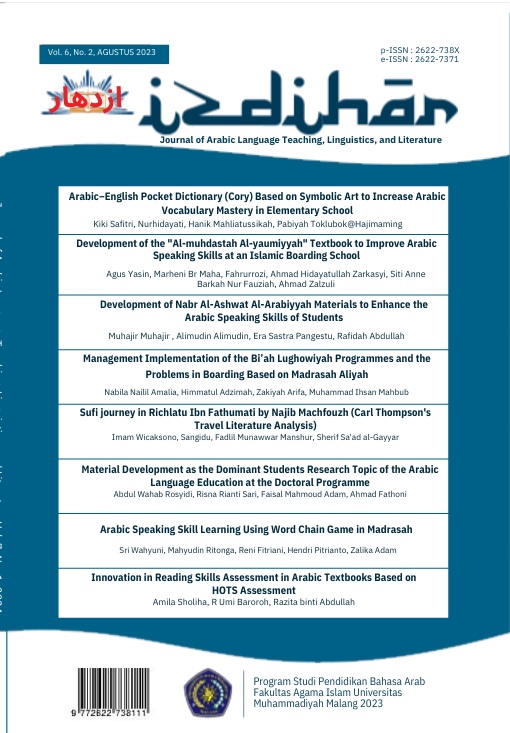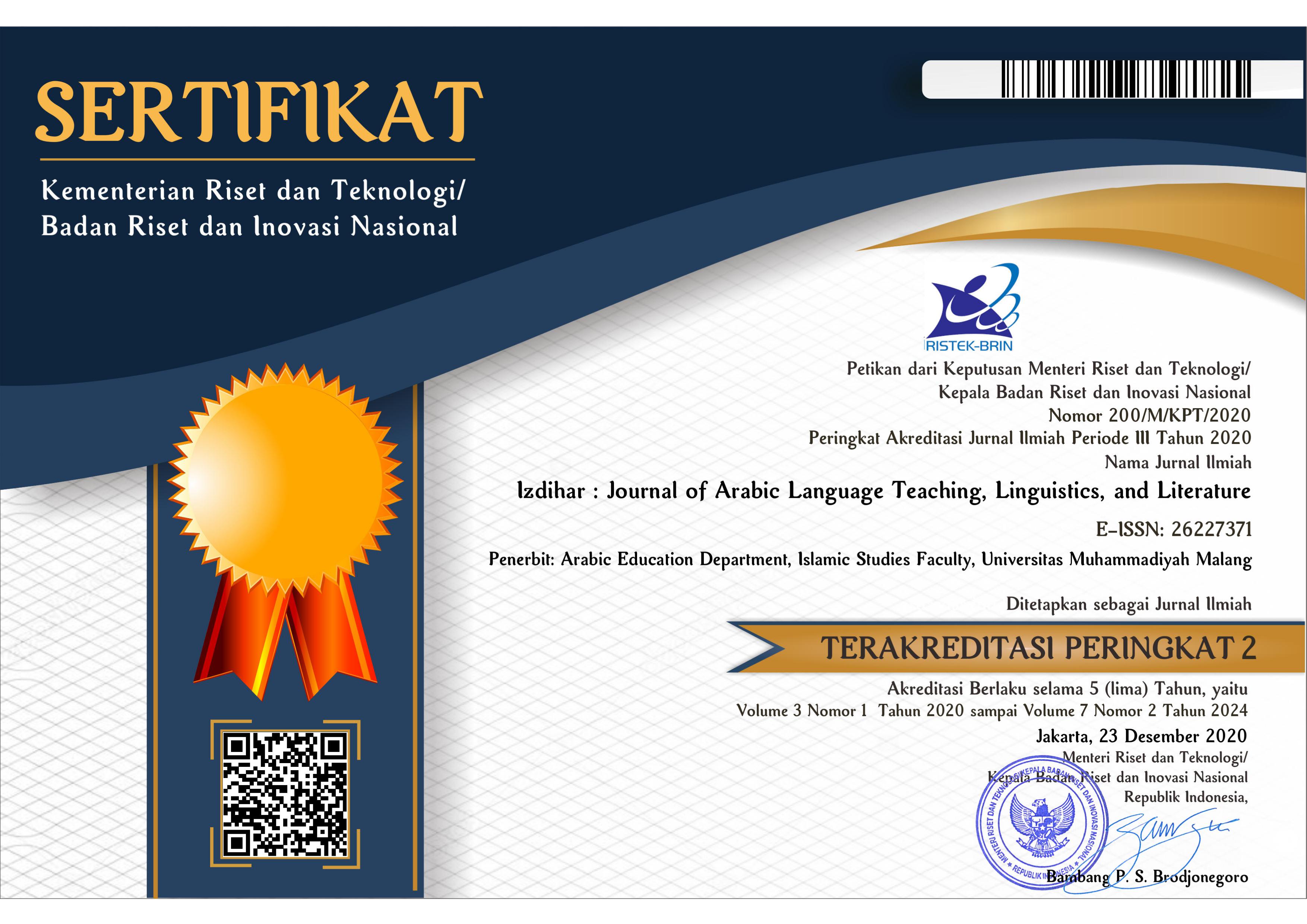Development of Nabr Al-Ashwat Al-Arabiyyah Materials to Enhance the Arabic Speaking Skills of Students
DOI:
https://doi.org/10.22219/jiz.v6i2.21954Keywords:
Development, Nabr Material, Maharah KalamAbstract
The purpose of this study was to determine how the development of nabr al-ashwat al-arabiyyah material improved the Arabic speaking skills of Muhammadiyah 3 Yogyakarta Junior High School students. This research utilised a research and development method with the ADDIE model, namely analysis, design, development, implementation and evaluation. The data collection process employed observation, questionnaires, interviews and tests. The results explain that judging from the average pre-test value, it can be said that nabr material has proven effective in improving the speaking proficiency of the material Arabic lessons in grade IX of Muhammadiyah 3 Yogyakarta Junior High School students. The researcher concluded that the development of nabr material from the pre-test results obtained an average value (mean) of 60.27, the minimal value being 48, the maximum value being 70 and the standard deviation being 6.036. while in the post-test table the average student score (mean) is 82.77, the minimum value being 70.00, the maximum value being 98.00 and the standard deviation being 8.149, which was proven by the effectiveness test using the JASP application. The paired samples t-test showed an increase in self-regulation (t (36) = -21.761, p <.001). This data shows that the p-value is <0.05; hence, it can be concluded that the data is significant. Furthermore, the Cohen's d table shows an effect of -3.627.
Downloads
References
Amin, N. (2019). Right Brain Empowerment in the Learning Process within the Classroom through the Hypnotic Language Transformation Pattern. Tamaddun, 18(1), 25–32. https://doi.org/10.33096/tamaddun.v18i1.25
Anam, Maltuful, and G. Z. A. S. M. (2023). Bahasa dan Gender (Kajian Sosial-Edukatif dalam Pembelajaran Bahasa Arab). Tanfidziya: Journal of Arabic Education, 2(3), 182–196. https://doi.org/https://doi.org/10.36420/tanfidziya.v2i03.322
Arsyad, M. H. (2019). Metode-Metode Pembelajaran Bahasa Arab Berdasarkan Pendekatan Komunikatif Untuk Meningkatkan Kecakapan Berbahasa. Jurnal Shaut Al-Arabiyah, 7(1), 13–30.
Asy’ari, Hasyim, and N. I. S. (2020). Aplikasi Pembelajaran Pusat Program Mingguan (PPM) Dalam Meningkatkan Kemampuan Berbicara Bahasa Arab (Maharah Al-Kalam) Siswa Di MTs Al Qodiri 1 Jember (Prodi Kelas Unggulan). Lisan An Nathiq: Jurnal Bahasa Dan Pendidikan Bahasa Arab, 1(2), 81–98. https://doi.org/https://doi.org/10.1234/lan.v2i2.3753
Beden, Sara, and I. Z. (2016). Pemetaan Struktur Peristiwa Bahasa: Komunikasi Bebas Konflik. GEMA Online Journal of Language Studies, 16(1). http://ejournal.ukm.my/gema/issue/view/750
Budiman, Agus, and M. A.-A. (2022). Penggunaan Media Youtube dalam Pembelajaran untuk Meningkatkan Maharah Al-Kalam Bahasa Arab. Jurnal Pendidikan Dan Konseling (JPDK), 4(6), 5827–5832. https://doi.org/10.31004/jpdk.v4i6.9213
Hadian, Latifah Hilda, Sugara Mochamad Hadad, and I. M. (2018). Penggunaan media big book untuk meningkatkan keterampilan membaca kalimat sederhana. Didaktik: Jurnal Ilmiah PGSD STKIP Subang, 4(2), 212–242. https://doi.org/10.36989/didaktik.v4i2.73
HS, M. M. (2016). Kajian Semantik Arab: klasik dan kontemporer. Prenada Media.
Isbah, F. (2023). Memahami Karakteristik Bahasa Arab untuk Pembelajaran. Bashrah, 3(1), 1–10. https://doi.org/10.58410/bashrah.v3i01.604
Kholisin, K. (2015). Pembelajaran kalam berbasis phonetic accuracy untuk meningkatkan kemampuan berbicara bahasa Arab. Bahasa Dan Seni: Jurnal Bahasa, Sastra, Seni, Dan Pengajarannya, 43(2). https://doi.org/http://journal2.um.ac.id/index.php/jbs/article/view/191
Manurung, Rosida Tiurma, Evany Victoriana, and A. E. A. (2021). Membangun Komunikasi Verbal Positif dalam Keluarga dengan Pengelolaan Emosi. Aksara: Jurnal Ilmu Pendidikan Nonformal, 7(1), 1339–1346. https://doi.org/http://dx.doi.org/10.37905/aksara.7.3.1339-1346.2021
Markus, Nengsih, Kusmiyati Kusmiyati, and S. S. (2017). Penguasaan Kosakata Bahasa Indonesia Anak Usia 4-5 Tahun. Jurnal Ilmiah FONEMA: Jurnal Edukasi Bahasa Dan Sastra Indonesia, 4(2). https://doi.org/10.25139/fn.v4i2.762
Maulinda, R. (2021). Peningkatan Keterampilan Berbicara dengan Pendekatan Komunikatif-Integratif di SMK Nusantara Plus Tangerang Selatan. GERAM, 9(1), 47–55. https://doi.org/10.25299/geram.2021.vol9(1).6283
Pebrian, M. Andhika, et al. (2023). Analisis Jenis Kalimat pada Teks Prosedur dalam Buku Teks Dasar-Dasar Teknik Pesawat Udara SMK/MAK Kelas X Kurikulum Merdeka. Jurnal Kajian Penelitian Pendidikan Dan Kebudayaan, 1(3), 111–137. https://doi.org/10.59031/jkppk.v1i3.150
Rahardi, R. Kunjana, Yuliana Setyaningsih, and R. P. D. (2015). Kata fatis penanda ketidaksantunan pragmatik dalam ranah keluarga. Adabiyyāt: Jurnal Bahasa Dan Sastra, 13(2), 149–175. https://doi.org/10.14421/ajbs.2014.13201
Raswan, R. (2019a). Dialek Laki-Laki dan Perempuan dalam Konteks Bahasa Arab. Al Mahāra: Jurnal Pendidikan Bahasa Arab, 5(2), 271–300. https://doi.org/https://doi.org/10.14421/almahara.2019.052.07
Raswan, R. (2019b). Dialek Laki-Laki dan Perempuan dalam Konteks Bahasa Arab. Al Mahāra: Jurnal Pendidikan Bahasa Arab, 5(2), 271–300. https://doi.org/10.14421/almahara.2019.052.07
Rifa’i, A. (2021). Kajian Filosofi Pendekatan Komunikatif dalam Pembelajaran Bahasa Arab. Jurnal Pendidikan Dan Pemikiran, 1(1), 60–74. https://ejournal-revorma.sch.id/index.php/mansa/issue/view/1
Rohmah, Ziyadatur, Bambang Yulianto, and M. M. (2019). Pemerolehan kalimat tanya bahasa Indonesia anak prasekolah usia 5—6 tahun. BELAJAR BAHASA: Jurnal Ilmiah Program Studi Pendidikan Bahasa Dan Sastra Indonesia, 4(2), 161–168. https://doi.org/10.32528/bb.v4i2.2122
Romanda, F. (2021). Makna Fonemik dalam Semantik Arab: Ontologi, Epistemologi, Aksiologi. Al-Ma ‘rifah: Jurnal Budaya, Bahasa, Dan Sastra Arab, 18(1), 67–76. https://doi.org/https://doi.org/10.21009/almakrifah.18.01.06
Sari, Ayu Kartika, and P. H. N. (2017). Fungsi Kata Umpatan pada Tokoh Sakuragi dalam Serial Televisi Jepang Dragon Zakura. Japanology, 6(1), 105–118.
Wulandari, N. (2020). Analisis kesalahan fonologis dalam keterampilan berbicara bahasa Arab. Jurnal Al-Fathin, 3(1), 71–84. https://doi.org/https://doi.org/10.32332/al-fathin.v3i01.2089
Zahroh, H., & Fitriani, I. N. (2020). Identifikasi Posisi An-Nabr dalam Kartun Muhsin Wa Mahasin Episode At-Tafakhur. 4(1), 229–248. https://doi.org/http://prosiding.arab-um.com/index.php/semnasbama/article/view/599/550
Downloads
Published
How to Cite
Issue
Section
License
Copyright (c) 2023 Muhajir Muhajir , Alimudin Alimudin, Era Sastra Pangestu, Rafidah Abdullah

This work is licensed under a Creative Commons Attribution-ShareAlike 4.0 International License.
Copyright Notice
Authors who publish with this journal agree to the following terms:
- Authors retain copyright and grant the journal right of first publication with the work simultaneously licensed under a Creative Commons Attribution-ShareAlike 4.0 International License that allows others to share the work with an acknowledgment of the work's authorship and initial publication in this journal.
- Authors are able to enter into separate, additional contractual arrangements for the non-exclusive distribution of the journal's published version of the work (e.g., post it to an institutional repository or publish it in a book), with an acknowledgment of its initial publication in this journal.
- Authors are permitted and encouraged to post their work online (e.g., in institutional repositories or on their website) prior to and during the submission process, as it can lead to productive exchanges, as well as earlier and greater citation of published work (See The Effect of Open Access).
Copyright (c) 2019 Izdihar : Journal of Arabic Language Teaching, Linguistics, and Literature

This work is licensed under a Creative Commons Attribution-ShareAlike 4.0 International License.


















